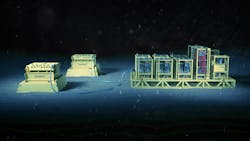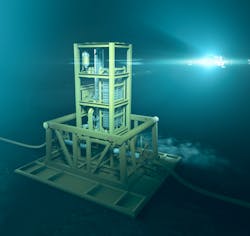New subsea processing tools designed to enhance recovery, lower capex
David McLaurin and Kendall Hawthorn, Intecsea, Worley Group
The offshore industry is entering a new era of opportunity for increased oil and gas recovery. The need to develop new methods to enable cost effective and reliable development of previously inaccessible reserves is on the forefront of operators’ objectives. There are currently many common goals amongst operators. The primary goals include increasing the economic benefits of brownfields and to move previously uneconomical greenfields to an economically feasible status.
Innovative technological advancements are being made today with these key goals as the driving factor. Along with advances to existing subsea processing technologies, such as subsea boosting, new subsea processing technologies are emerging across the industry. In alignment with the theme for the 2020 Worldwide Survey of Subsea Processing poster, this article discusses emerging subsea processing technologies which enable lower capex, greater product recovery, reduced operational CO2 emissions, and lower risk.
Status of subsea processing
Since its inception, subsea processing has maintained the primary goal of enabling operators to develop fields that historically, have not been economically viable, as well as allowing for recovery of additional reserves from already economical fields. The equipment on the seabed may also reduce topsides facilities space and weight requirements. Operators are now able to achieve project goals with the use of new and emerging subsea processing technologies. Subsea processing is now considered a viable option for the majority of deepwater projects and continues to grow as an accepted solution for many different applications.
New boosting technologies
A primary industry accepted solution for subsea fields with marginal wells is subsea boosting. While very beneficial, subsea boosting on a project also comes with cost, risk and complexity. Reliability vs. availability of subsea boosting systems is always a topic of concern and has driven many suppliers to constantly update and advance their subsea boosting systems. New boosting technologies have resulted in more reliable boosting with more options to maintain system availability.
The FASTsubsea X pump module is one promising new technology. FASTsubsea is a new company which combines Aker Solutions’ high-performance multiphase MultiBooster technology with FSubsea’s game-changing Hydromag technology to create the world’s first ‘topside-less’ multiphase boosting system. Alexander Fuglesang, managing director of FASTsubsea, says that “overall, at high level, the pump module itself (which removes the need for topsides HPU, VSD and barrier-fluid lines in the umbilical) actually constitutes the bulk of the whole pump system.” The FASTsubsea pump module is expected to drastically reduce subsea pump system cost, decrease risk and increase system reliability. The FASTsubsea X pump module is expected to be TRL 4 in 2022.
Other new boosting technologies include the Aptara Modular Compact Pump from Baker Hughes and the Barrier Fluidless Subsea Pump from Saipem and Curtis Wright.
The Aptara Modular Compact Pump is expected to have a much higher power density than traditional subsea multiphase pumps. It is also a barrier fluid-less pump, significantly reducing requirements on topsides space and reducing umbilical requirements. The pump consists of independently controllable stages, with individual motors integrated onto each rotor rotating around a static central shaft. This avoids some of the rotor dynamic issues associated with conventional pumps, as well as the need for a mechanical seal. The modules can be stacked and built-up into larger systems depending on process needs. A typical pump is expected to stack between four and 24 stages, giving a pump equivalent shaft power ranging from 1 to 6 MW.
The Barrier Fluid-less Subsea Pump is under development by Saipem and Curtis Wright and will use marinized canned motors from Curtis Wright to eliminate complicated barrier fluid system requirements from the pump motor.
Tieback distance capabilities can also be extended much farther than previous subsea pump systems. With the development of Siemens’ Power Grid and ABB’s Subsea Power Distribution and Conversion Technology systems, the industry now has the option to locate on the seafloor the transformer, variable frequency drive (VFD) and switchgear, eliminating the complications that come with large separations between the VFD and the pump motor. Voltage can be stepped up as well, reducing power lost across long tiebacks.
Emerging processing technologies
In the interest of bringing currently inaccessible subsea fields to a feasibly economical and executable level, many technologies are currently in development.
The Pseudo Dry Gas (PDG) technology concept by Intecsea has been demonstrated for transporting wet gas over tieback pipelines in excess of 300 km (186 mi) in deepwater. This technology uses multiple gravity based piggable liquid extraction units to reduce the well back pressure by reducing the liquid content to an extent where ‘dry gas’ pressure losses are seen. Removing the gravitational pressure loss mode allows the use of larger pipelines which minimize the frictional pressure drop. The liquids removed from the pipeline are collected in buffer tanks and pumped back to the host facility through a small flowline or even an umbilical tube. The result of the Pseudo Dry Gas system is increased production, increase longer tieback length capability, lower chemical injection requirements, and produce a smaller carbon footprint as compared to other subsea wet gas processing technologies. The PDG system is currently prototype testing and is expected to be available for subsea projects in 2022.
Aside from technologies specific to direct boosting, there are also emerging technologies which enable moving of equipment from the host facility to subsea.
Water injection is the most common way to enhance oil production, but generally has required expensive and bulky topsides equipment. The “SWIT technology” (including “Seabox”) by NOV and equivalent technologies from suppliers across the industry enable disinfection, particle removal, and other treatment at the subsea field location. By using raw seawater to clean and inject at the subsea water injection location, all topsides water injection equipment as well as water injection risers and flowlines from the host facility can be removed from the system. In applications with low reservoir pressures, this technology even eliminates the need for water injection pumps. Seabox is currently TRL 6, with the additional SWIT technologies at TRL 4.
Another technology that tackles the marinization of traditionally topsides equipment is subsea chemical storage, pumping and injection. Saipem, NOV, Seatools, and Oceaneering are currently making this a reality. Subsea chemical storage, pumping and injection systems enable subsea storage and injection of production chemicals such as inhibitors and biocides. The process of developing this technology included consideration of durability, chemical pump reliability, chemical compatibility, chemical lifespans, logistics of refilling chemicals, leakage monitoring and control and required instrumentation. This technology allows significant reduction of cost related to offshore umbilicals. Opex vs. capex has been weighed throughout the design stages of subsea chemical storage and injection and the benefits of this technology for fields with significant tieback distances are clear. Saipem intends to have this technology at TRL 4 in 2020.
Many more subsea processing technologies are currently under development with the primary goal of decreasing capex and enabling further development of offshore fields. For a complete list of emerging processing technologies identified in the subsea field, see Table 4: 2020 Supplier Item Listing with Current and Projected TRLs For Emerging Technology, on the poster.
Subsea processing poster
This issue of Offshore also contains the 2020 Worldwide Survey of Subsea Processing poster, the thirteenth release of this industry resource. The primary aims of this poster are to chronicle the development and developers of these systems and to document the continued commitment of oil companies to the application of these technologies.
A useful new feature on the electronic version of the 2020 Worldwide Survey of Subsea Processing poster is the inclusion of the Offshore magazine/Intecsea Youtube channel link. This link provides ready access to an arrangement of more than 50 videos on subsea processing technology. These videos enable the viewer to rapidly increase their understanding of the various emerging technologies available and how adoption of these technologies may provide great benefit for future field development projects. Potential benefits may be seen in the overall profitability of projects and improved environmental performance. •

